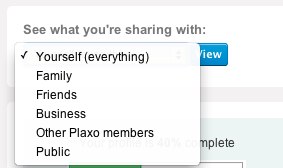Note: a while back, Christian Crumlish & Erin Malone asked me to write a sidebar for a book they were working on … an ambitious tome of design patterns for social software. The book, (Designing Social Interfaces) was published last year, and it’s excellent. I’m proud to be part of it. Christian encouraged contributors to publish their portions online … I’m finally getting around to doing so.
In addition to what I’ve posted below, I’ll point out that there have been several infamous screw-ups with context management since I wrote this … including Google Buzz and Facebook’s Groups, Places and other services.
Also to add: I don’t think we need a new discipline for context management. To my mind, it’s just good information architecture.
——————
There was a time when we could be fairly certain where we were at any given time. Just looking at one’s surroundings would let us know if we were in a public park or a quiet library, a dance hall or a funeral parlor. And our actions and conversations could easily adapt to these contexts: in a library, we’d know not to yell “heads up” and toss a football, and we’d know to avoid doing the hustle during someone’s eulogy.
But as more and more of our lives are lived via the web, and the contexts we inhabit are increasingly made of digits rather than atoms, our long-held assumptions about reality are dissolving under our typing-and-texting fingertips.
A pre-web example of this problem is something most people have experienced: accidentally emailing with “reply all” rather than “reply.” Most email applications make it brutally easy to click Reply All by accident. In the physical world in which we evolved, the difference between a private conversation and a public one required more physical effort and provided more sensory clues. But in an email application, there’s almost no difference: the buttons are usually identical and only a few pixels apart.
You’d think we would have learned something from our embarrassments with email, but newer applications aren’t much of an improvement. Twitter, for example, allows basically the same mistake if you use “@” instead of “d.” Not only that, but you have to put a space after the “d.”
Twitter users, by the time of this writing, are used to seeing at least a few of these errors made by their friends every week, usually followed by another tweet explaining that was a “mis-tweet” or cursing the d vs @ convention.
At least with those applications, it’s basically a binary choice for a single piece of data: one message goes either to one or multiple recipients: the contexts are straightforward, and relatively transparent. But on many popular social nework platforms, the problem becomes exponentially more complicated.
Because of its history, Facebook is an especially good example. Facebook started as a social web application with a built-in context: undergraduates at Harvard. Soon it expanded to other colleges and universities, but its contextual architecture continued to be based on school affiliation. The power of designing for a shared real-world context allowed Facebook’s structure to assume a lot about its users: they would have a lot in common, including their ages, their college culture, and circles of friends.
Facebook’s context provided a safe haven for college students to express themselves with their peers in all their immature, formative glory; for the first time a generation of late-teens unwittingly documented their transition to adulthood in a published format. But it was OK, because anybody on Facebook with them was “there” only because they were already “there” at their college, at that time.
But then, in 2006 when Facebook opened its virtual doors to anyone 13 or over with an email address, everything changed. Graduates who were now starting their careers found their middle-aged coworkers asking to be friends on Facebook. I recall some of my younger office friends reeling at the thought that their cube-mates and managers might see their photos or read their embarrassing teenage rants “out of context.”
The Facebook example serves a discussion of context well because it’s probably the largest virtual place to have ever so suddenly unhinged itself from its physical place. Its inhabitants, who could previously afford an assumed mental model of “this web place corresponds to the physical place where I spent my college years,” found themselves in a radically different place. A contextual shift that would have required massive physical effort in the physical world was accomplished with a few lines of code and the flip of a switch.
Not that there wasn’t warning. The folks who run Facebook had announced the change was coming. So why weren’t more people ready? In part because such a reality shift doesn’t have much precedent; few people were used to thinking about the implications of such a change. But also because the platform didn’t provide any tools for managing the context conversion.
This lack of tools for managing multiple contexts is behind some of the biggest complaints about Facebook and social network platforms (such as MySpace and LinkedIn). For Facebook, long-time residents realized they would like to still keep up their immature and embarrassing memories from college to share just with their college friends, just like before — they wanted to preserve that context in its own space. But Facebook provided no capabilities for segmenting the experience. It was all or nothing, for every “friend” you added. And then, when Facebook launched its News feed — showing all your activities to your friends, and those of your friends to you — users rebelled in part because they hadn’t been given adequate tools for managing the contexts where their information might appear. This is to say nothing of the disastrous launch of Facebook’s “Beacon” service, where all users were opted in by default to share information about their purchases on other affiliated sites.
On MySpace, the early bugbear was the threat of predator activity and the lack of privacy. Again, the platform was built with the assumption that users were fine with collapsing their contexts into one space, where everything was viewable by every “friend” added. And on LinkedIn, users have often complained the platform doesn’t allow them to keep legitimate peer connections separate from others such as recruiters.
Not all platforms have made these mistakes. The Flickr photo site has long distinguished between Family and Friends, Private and Public. LiveJournal, a pioneering social platform, has provided robust permissions controls to its users for years, allowing creation of many different user-and-group combinations.
However, there’s still an important missing feature, one which should be considered for all social platforms even as they add new context-creation abilities. It’s either impossible or difficult for users to review their profiles and posts from others’ point of view.
Giving users the ability to create new contexts is a great step, but they also need the ability to easily simulate each user-category’s experience of their space. If a user creates a “co-workers” group and tries to carefully expose only their professional information, there’s no straightforward way to view their own space using that filter. With the Reply All problem described earlier, we at least get a chance to proof-read our message before hitting the button. But most social platforms don’t even give us that ability.
This function — perhaps call it “View as Different User Type” — is just one example of a whole class of design patterns we still need for managing the mind-bending complexity we’ve created for ourselves on the web. There are certainly others waiting to be explored. For example, what if we had more than just one way to say “no thank you” to an invitation or request, depending on type of person requesting? Or a way to send a friendly explanatory note with your refusal, thereby adding context to an otherwise cold interaction? Or what about the option to simply turn off whole portions of site functionality for some groups and not others? Maybe I’d love to get zombie-throwing-game invitations from my relatives, but not from people I haven’t seen since middle school?
In the rush to allow everyone to do everything online, designers often forget that some of the limitations of physical life are actually helpful, comforting, and even necessary. We’re a social species, but we’re also a nesting species, given to having our little nook in the tribal cave. Maybe we should take a step back and think of these patterns not unlike their originator, Mr Alexander, did — how have people lived and interacted successfully over many generations? What can we learn from the best of those structures, even in the structureless clouds of cyberspace? Ideally, the result would be the best of both worlds: architectures that fit our ingrained assumptions about the world, while giving us the magical ability to link across divides that were impossible to cross before.




